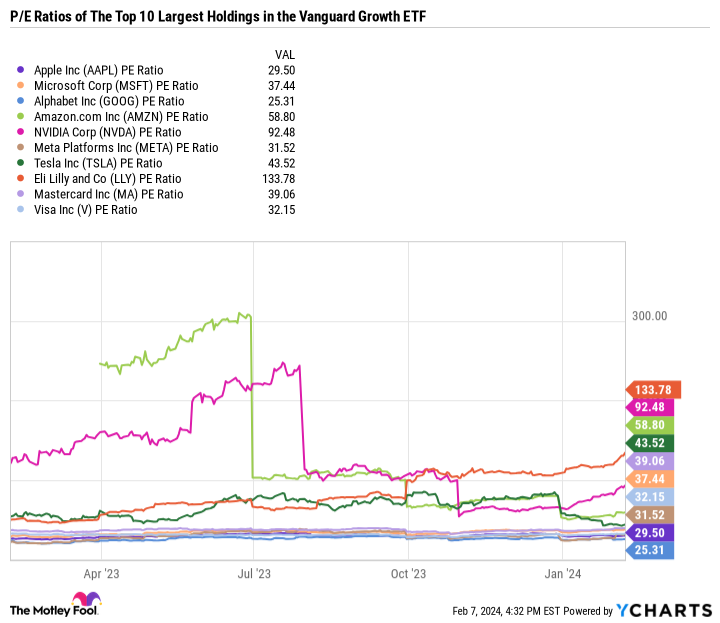After blasting to a new 52-week high late last year, the Vanguard Growth ETF (NYSEMKT: VUG) has finally surpassed its previous all-time intraday and closing highs from November 2021.
As of market close on Feb. 8, the fund is up a jaw-dropping 38.3% over the last year, which is even better than the Nasdaq Composite‘s performance.
Here’s why the ETF is doing well and what it would take to keep soaring from here.
An investment in market leadership
It’s no secret that today’s market leaders are growth companies, specifically big-tech companies with artificial intelligence ambitions. The simplest reason to invest in the Vanguard Growth ETF is because you think that trend will continue.
For a mere 0.04% expense ratio, or $4 for every $10,000 invested, the ETF grants exposure to all of the top growth stocks across a wide variety of sectors and on both exchanges, the Nasdaq Composite and the New York Stock Exchange. This approach is different from the Nasdaq Composite, which only targets the largest companies traded on the Nasdaq exchange.
Here are the ETF’s top 10 largest holdings as of Dec. 31, as well as the top 10 holdings in the Vanguard S&P 500 ETF (NYSEMKT: VOO), which mirrors the performance of the S&P 500.
|
Company |
Vanguard Growth ETF |
Company |
Vanguard S&P 500 ETF |
|---|---|---|---|
|
Apple |
13% |
Apple |
7% |
|
Microsoft |
12.8% |
Microsoft |
7% |
|
Alphabet |
6.9% |
Alphabet |
3.8% |
|
Amazon |
6.5% |
Amazon |
3.4% |
|
Nvidia |
5.3% |
Nvidia |
3% |
|
Meta Platforms |
3.6% |
Meta Platforms |
2% |
|
Tesla |
3.1% |
Tesla |
1.7% |
|
Eli Lilly |
2.3% |
Berkshire Hathaway |
1.6% |
|
Visa |
1.8% |
JPMorgan Chase |
1.2% |
|
Mastercard |
1.6% |
Broadcom |
1.2% |
Data source: Vanguard.
As you can see in the table, the top 10 largest holdings make up 56.9% of the Vanguard Growth ETF — a far higher concentration than the Vanguard S&P 500 ETF, which has a 31.9% concentration in its top 10 largest holdings.
A highly concentrated portfolio isn’t necessarily a bad thing. After all, famed investors like Warren Buffett, Peter Lynch, and Stanley Druckenmiller have long touted the advantages of going with your best ideas instead of overly diversifying. In many ways, the Vanguard Growth ETF takes this same approach by going with the market’s best growth stocks, or at least the growth stocks that are the most valuable.
Riding the wave
Risk-tolerant investors, or really anyone who wants more growth in their portfolio than value or income, may prefer the Vanguard Growth Fund to the Vanguard S&P 500 ETF. However, there are dangers to investing solely in one “type” of stock or going all in on a certain sector.
There are plenty of differences between Amazon and Tesla, Apple and Nvidia, etc. But these “Magnificent Seven” companies are seen as more similar investments than, say, Nvidia and Procter & Gamble, which are polar opposites. The big tech stocks can be correlated during a market expansion and a contraction. We saw this relationship play out during the downturn in 2022, as well as during last year’s booming market.
The best use of the Vanguard Growth ETF is to get a starting position in several top market leaders. The fund is top-heavy in its individual holdings and concentrated in a few sectors (over 75% of the fund is in technology and consumer discretionary stocks). Investing solely in the fund is risky in its own right, but including the fund in a portfolio’s growth allocation could be a wise decision.
A check and balance on the temptation to take unnecessary action
Perhaps the fund’s best quality is that it encourages the long-term mindset needed to invest in the U.S. stock market and compound wealth over time.
It can be tempting to sell an individual stock if it is doing poorly or collect gains from an unexpected pop in a stock. But it’s easier to simply hold the Vanguard Growth ETF or even gradually add to it over time. In other words, sticking with an ETF and avoiding the distractions of market noise is easier than piling into one big tech stock and feeling the pressure of every price movement.
With over $200 billion in net assets, The Vanguard Growth ETF is one of the largest ETFs out there. Vanguard is also one of the most reputable and proven players in the ETF business, so investors can count on wise rebalances and management of the fund.
The ETF’s biggest red flag
The Vanguard Growth ETF can serve as the perfect role-player in a diversified portfolio. It’s a particularly good bet if you don’t know where to start, are building a new portfolio, or simply want a catch-all way to invest in leading technologies but want more exposure to those top companies than an S&P 500 ETF gives you.
It goes without saying that the Vanguard Growth ETF is far more expensive than it used to be — trading at a 40.1 price-to-earnings (P/E) ratio. However, the S&P 500 and many leading tech stocks are also more expensive. The Vanguard S&P 500 ETF has a 25 P/E ratio. All of the top 10 largest holdings in the Vanguard Growth ETF have a P/E above 25, and six of them have a P/E above 35.
In sum, the market is expensive. And participating in the market requires accepting that fact.
An option for everybody
The Vanguard Growth ETF can check a much-needed box for all kinds of investors. It can provide baseline exposure to the Magnificent Seven stocks. It can act as a means to invest in growth without betting too much on a single company. It can be a way to invest in today’s market leaders. And it can act as a way to dip your toes into big tech without the risks of picking the wrong stock (since you get all the top players with an ETF).
As long as the current trajectory of the market continues, the Vanguard Growth ETF should continue to soar. But also note that if the market does pull back, the Vanguard Growth ETF will likely get hit hard as well.
Should you invest $1,000 in Vanguard Index Funds – Vanguard Growth ETF right now?
Before you buy stock in Vanguard Index Funds – Vanguard Growth ETF, consider this:
The Motley Fool Stock Advisor analyst team just identified what they believe are the 10 best stocks for investors to buy now… and Vanguard Index Funds – Vanguard Growth ETF wasn’t one of them. The 10 stocks that made the cut could produce monster returns in the coming years.
Stock Advisor provides investors with an easy-to-follow blueprint for success, including guidance on building a portfolio, regular updates from analysts, and two new stock picks each month. The Stock Advisor service has more than tripled the return of S&P 500 since 2002*.
*Stock Advisor returns as of February 5, 2024
JPMorgan Chase is an advertising partner of The Ascent, a Motley Fool company. Randi Zuckerberg, a former director of market development and spokeswoman for Facebook and sister to Meta Platforms CEO Mark Zuckerberg, is a member of The Motley Fool’s board of directors. John Mackey, former CEO of Whole Foods Market, an Amazon subsidiary, is a member of The Motley Fool’s board of directors. Suzanne Frey, an executive at Alphabet, is a member of The Motley Fool’s board of directors. Daniel Foelber has no position in any of the stocks mentioned. The Motley Fool has positions in and recommends Alphabet, Amazon, Apple, Berkshire Hathaway, JPMorgan Chase, Meta Platforms, Microsoft, Nvidia, Tesla, Vanguard Index Funds – Vanguard Growth ETF, and Vanguard S&P 500 ETF. The Motley Fool recommends Broadcom. The Motley Fool has a disclosure policy.
Vanguard’s Largest Growth Fund Just Hit an All-Time High. Is There More Room to Run? was originally published by The Motley Fool
Signup bonus from






